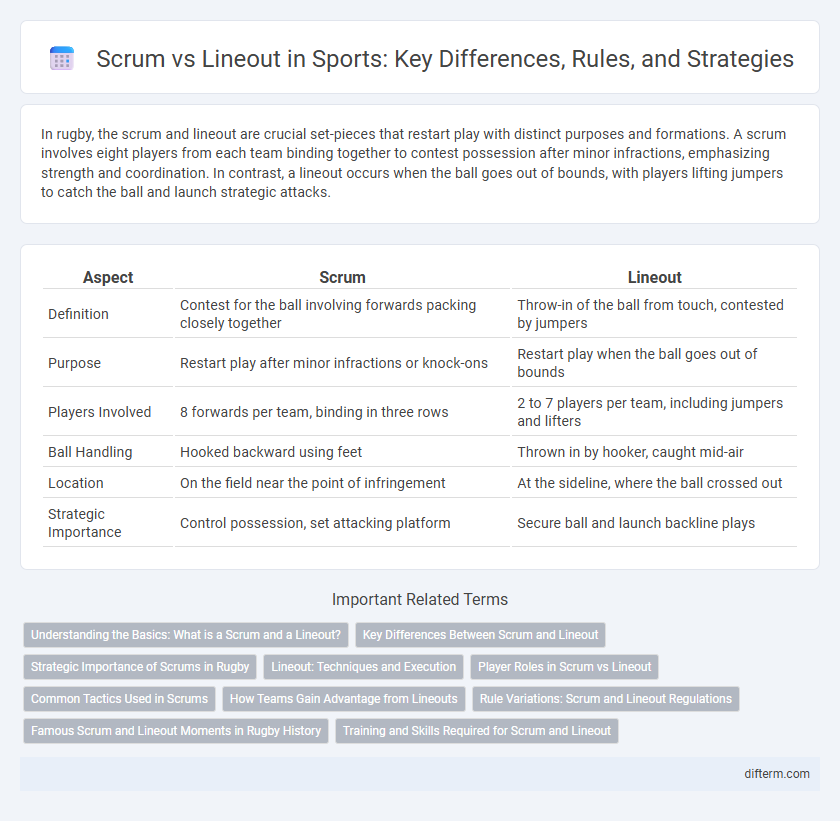In rugby, the scrum and lineout are crucial set-pieces that restart play with distinct purposes and formations. A scrum involves eight players from each team binding together to contest possession after minor infractions, emphasizing strength and coordination. In contrast, a lineout occurs when the ball goes out of bounds, with players lifting jumpers to catch the ball and launch strategic attacks.
Table of Comparison
| Aspect | Scrum | Lineout |
|---|---|---|
| Definition | Contest for the ball involving forwards packing closely together | Throw-in of the ball from touch, contested by jumpers |
| Purpose | Restart play after minor infractions or knock-ons | Restart play when the ball goes out of bounds |
| Players Involved | 8 forwards per team, binding in three rows | 2 to 7 players per team, including jumpers and lifters |
| Ball Handling | Hooked backward using feet | Thrown in by hooker, caught mid-air |
| Location | On the field near the point of infringement | At the sideline, where the ball crossed out |
| Strategic Importance | Control possession, set attacking platform | Secure ball and launch backline plays |
Understanding the Basics: What is a Scrum and a Lineout?
A scrum is a method of restarting play in rugby where eight players from each team bind together and push against the opposing pack to compete for the ball. A lineout occurs when the ball goes out of bounds, with players from both teams lining up perpendicular to the touchline and jumping to catch the thrown ball. Both techniques are essential for maintaining possession and securing strategic advantage during match play.
Key Differences Between Scrum and Lineout
Scrum and lineout are two fundamental set pieces in rugby with distinct rules and purposes. A scrum involves eight players from each team binding together to contest possession after minor infractions, emphasizing teamwork and physical strength, while a lineout restarts play after the ball goes into touch, requiring precise throwing and jumping techniques to regain possession. The scrum centers on pushing power and engagement between forwards, whereas the lineout prioritizes timing, coordination, and aerial skill to secure the ball.
Strategic Importance of Scrums in Rugby
Scrums in rugby serve as critical platforms for tactical dominance and ball possession, allowing teams to execute planned moves and maintain offensive momentum. The controlled environment of the scrum enables forwards to assert physical superiority, disrupting opposition formations and creating space for backs to exploit. Mastery of scrum technique directly influences game tempo and can decisively impact scoring opportunities through set-piece efficiency.
Lineout: Techniques and Execution
Lineouts in rugby require precise coordination, involving lifters hoisting jumpers to catch or tap the ball effectively during throw-ins. Mastery of timing, communication, and body positioning ensures successful ball retention or turnover opportunities. Teams often use set-piece variations and signals to outmaneuver opponents and gain tactical advantage in this critical phase of play.
Player Roles in Scrum vs Lineout
In rugby, player roles in a scrum involve the front row engaging physically to contest possession, with props providing stability and the hooker executing ball retrieval. Conversely, during a lineout, players specialize in jumping and lifting, where locks and flankers coordinate timing and elevation to secure the ball. Understanding these distinct responsibilities enhances team strategy and effectiveness in set-piece situations.
Common Tactics Used in Scrums
In rugby, scrums employ tactics such as coordinated pushing, where the pack drives forward in unison to gain territory and control. Teams strategically position their strongest forwards in the front row to dominate opponents and secure possession of the ball. Effective communication and timing during the engagement phase can disrupt the opposing scrum, creating opportunities for quick ball distribution.
How Teams Gain Advantage from Lineouts
Teams gain a strategic advantage from lineouts by effectively coordinating lifts and timing throws to secure clean possession, disrupting the opposing team's rhythm. Precise communication and practiced formations enable attacking teams to execute set-piece plays that create space and scoring opportunities. Defensive lineouts focus on reading the throw and contesting possession, preventing opponents from building momentum through structured plays.
Rule Variations: Scrum and Lineout Regulations
Scrum regulations dictate precise formations, including the binding of eight players per team and requirements for a straight feed of the ball to ensure fair contest for possession. Lineout rules specify player spacing, the number of jumpers allowed, and allowable lifting techniques to maintain safety and competitive balance. Variations in these rules can differ by league or level of play, affecting the strategies employed during set-pieces in rugby union matches.
Famous Scrum and Lineout Moments in Rugby History
The 2015 Rugby World Cup final featured a legendary scrum by New Zealand that showcased their dominance over Australia, setting the tone for the match. One of the most iconic lineout moments occurred during the 2003 Rugby World Cup final when England executed a perfect catch and maul, leading to a decisive try against Australia. These moments highlight the strategic importance of scrums and lineouts in rugby, where precision and timing can determine the outcome of high-stakes games.
Training and Skills Required for Scrum and Lineout
Mastering the scrum demands intensive strength training, precise body positioning, and synchronized teamwork to ensure effective engagement and ball control. Lineout skills require players to develop accurate throwing techniques, timing, and coordination for effective lifting and jumping, emphasizing flexibility and explosive power. Both set pieces necessitate strategic communication and consistent practice to enhance execution under game pressure.
scrum vs lineout Infographic

 difterm.com
difterm.com